A Novel Low-Power Bipolar DC–DC Converter with Voltage Self-Balancing
Abstract
1. Introduction
2. Topology Derivation and Working Principles
- The converter operates under continuous conduction mode (CCM);
- All components are assumed to be ideal, and their parasitic parameters are neglected;
- Capacitors are sufficiently large to neglect voltage ripple effects.
3. Performance Analysis
3.1. Voltage Gain Analysis
3.2. Voltage and Current Stress Analysis of the Device
3.3. Comparative Analysis
4. Experimental Validation
4.1. The Experimental Results of the Steady-State
4.2. The Experimental Results of the Voltage Self-Balancing
5. Loss and Efficiency
- (1)
- Switching losses
- (2)
- Diode losses
- (3)
- Capacitor losses
- (4)
- Inductor losses
- a.
- Core loss calculations:
- b.
- Copper loss calculation:
- (5)
- Other losses: Approximately 0.4 W (0.1% of total power) including wire losses.
6. Conclusions
- The proposed bipolar converter exhibits excellent self-balanced characteristics for the output voltages between bipolar terminals;
- The structure of the converter is simple, containing only a single active switch, and it maintains the control and driving methods of the Boost converter without any alterations;
- The proposed structure is scalable, and since there are no active components in the expansion units, it will not affect the control method of the converter.
Author Contributions
Funding
Data Availability Statement
Conflicts of Interest
References
- Hinov, N.; Grigorova, T. A Comprehensive Analysis of Losses and Efficiency in a Buck ZCS Quasi-Resonant DC/DC Converter. J. Low Power Electron. Appl. 2025, 15, 34. [Google Scholar] [CrossRef]
- Caselli, M.; Ronchi, M.; Boni, A. Power Management Circuits for Low-Power RF Energy Harvesters. J. Low Power Electron. Appl. 2020, 10, 29. [Google Scholar] [CrossRef]
- Zhu, B.; Wang, H.; Zhang, Y.; Chen, S. Buck-Based Active-Clamp Circuit for Current-Fed Isolated DC–DC Converters. IEEE Trans. Power Electron. 2022, 37, 4337–4345. [Google Scholar] [CrossRef]
- Zhu, B.; Yang, Y.; Wang, K.; Liu, J.; Vilathgamuwa, D.M. High Transformer Utilization Ratio and High Voltage Conversion Gain Flyback Converter for Photovoltaic Application. IEEE Trans. Ind. Appl. 2024, 60, 2840–2851. [Google Scholar] [CrossRef]
- Babu, V.V.; Roselyn, J.P.; Sundaravadivel, P. Coordination of SRF-PLL and Grid Forming Inverter Control in Microgrid with Solar PV and Energy Storage. J. Low Power Electron. Appl. 2024, 14, 29. [Google Scholar] [CrossRef]
- Shaukat, H.; Ali, A.; Ali, S.; Altabey, W.A.; Noori, M.; Kouritem, S.A. Applications of Sustainable Hybrid Energy Harvesting: A Review. J. Low Power Electron. Appl. 2023, 13, 62. [Google Scholar] [CrossRef]
- Ibude, F.; Otebolaku, A.; Ameh, J.E.; Ikpehai, A. Multi-Timescale Energy Consumption Management in Smart Buildings Using Hybrid Deep Artificial Neural Networks. J. Low Power Electron. Appl. 2024, 14, 54. [Google Scholar] [CrossRef]
- Udeji, U.L.; Margala, M. OptimalNN: A Neural Network Architecture to Monitor Chemical Contamination in Cancer Alley. J. Low Power Electron. Appl. 2024, 14, 33. [Google Scholar] [CrossRef]
- Yang, Y.; Zhu, B.; She, X.; Wang, K.; Liu, A. A Family of Bipolar DC–DC Converters with Interpolar Voltage Self-Balancing Based on FB-BVMs for BLVDC Microgrid. IEEE Trans. Ind. Electron. 2025, 1–10. [Google Scholar] [CrossRef]
- Yang, Y.; Zhu, B.; She, X.; Wang, K.; Liu, A. A Family of Voltage Balancers with Fault-Tolerance and Interpolar Voltage Self-Balancing Ability for Bipolar DC Power Systems. IEEE Trans. Transp. Electrif. 2025, 11, 9864–9876. [Google Scholar] [CrossRef]
- Ren, Q.; Han, Y.; Zhou, M.; Yan, C.; Yang, P.; Wang, C. Overview of Voltage Balancing Schemes in Bipolar DC Microgrids. IEEE Trans. Power Electron. 2025, 40, 3469–3489. [Google Scholar] [CrossRef]
- Pires, V.F.; Cordeiro, A.; Roncero-Clemente, C.; Rivera, S.; Dragičević, T. DC-DC Converters for Bipolar Microgrid Voltage Balancing: A Comprehensive Review of Architectures and Topologies. IEEE J. Emerg. Sel. Top. Power Electron. 2022, 11, 981–998. [Google Scholar] [CrossRef]
- Rivera, S.; Lizana, R.; Kouro, S.; Dragičević, T.; Wu, B. Bipolar DC Power Conversion: State-of-the-Art and Emerging Technologies. IEEE J. Emerg. Sel. Top. Power Electron. 2021, 9, 1192–1204. [Google Scholar] [CrossRef]
- Wang, F.; Lei, Z.; Xu, X.; Shu, X. Topology Deduction and Analysis of Voltage Balancers for DC Microgrid. IEEE J. Emerg. Sel. Top. Power Electron. 2017, 5, 672–680. [Google Scholar] [CrossRef]
- Liu, X.; Wu, X.; Chen, X.; Zhao, X. A bidirectional resonant CLLC converter combining three-level characteristic and bipolar DC structure. Int. J. Circuit Theory Appl. 2024, 52, 6151–6181. [Google Scholar] [CrossRef]
- Tian, Q.; Zhang, X.; Zhou, G.; Li, H.; Ma, H. Improved Dual Active Bridge DC–DC Converter with Symmetric Bipolar Output by Utilizing a Switched-Capacitor Circuit for Bipolar DC Distribution System. IEEE Trans. Ind. Electron. 2024, 71, 524–536. [Google Scholar] [CrossRef]
- Xiong, W.; Wang, M.; Ning, G.; Sun, Y.; Su, M. A ZVS Branch-Sharing Partial Power Converter with Bipolar Voltage Regulation Capability. IEEE Trans. Ind. Electron. 2024, 71, 1572–1582. [Google Scholar] [CrossRef]
- Ai, J.; Yang, X.; Shen, Y.; Ni, H.; Bi, K.; Fan, Q. A family of interleaved isolated three-level DC/DC converters. IET Power Electron. 2024, 17, 2861–2877. [Google Scholar] [CrossRef]
- Lin, Y.; Zhou, F.; Xu, G.; Xiong, W.; Ning, G. Bipolar Current-Fed DC–DC Converter with Automatic Voltage Balance and Full Range ZVS for Bipolar DC System. IEEE Trans. Power Electron. 2024, 39, 4248–4259. [Google Scholar] [CrossRef]
- Kakigano, H.; Miura, Y.; Ise, T. Low-Voltage Bipolar-Type DC Microgrid for Super High Quality Distribution. IEEE Trans. Power Electron. 2010, 25, 3066–3075. [Google Scholar] [CrossRef]
- Kim, H.-J.; Han, B.-M. Operation analysis of bipolar DC distribution system with new half-bridge voltage balancer. In Proceedings of the 2015 IEEE International Conference on Building Efficiency and Sustainable Technologies, Singapore, 31 August–1 September 2015; pp. 62–67. [Google Scholar]
- Ma, J.; Li, Y.; Zhu, M.; Cai, X. Parallel operation of distributed voltage balancers for bipolar DC system with improved reliability and efficiency. In Proceedings of the IECON 2017-43rd Annual Conference of the IEEE Industrial Electronics Society, Beijing, China, 29 October–1 November 2017; pp. 1387–1392. [Google Scholar]
- Liu, C.; Zhu, D.; Zhang, J.; Liu, H.; Cai, G. A Bidirectional Dual Buck-Boost Voltage Balancer with Direct Coupling Based on a Burst-Mode Control Scheme for Low-Voltage Bipolar-Type DC Microgrids. J. Power Electron. 2015, 15, 1609–1618. [Google Scholar] [CrossRef]
- Rivera, S.; Wu, B.; Kouro, S.; Yaramasu, V.; Wang, J. Electric Vehicle Charging Station Using a Neutral Point Clamped Converter with Bipolar DC Bus. IEEE Trans. Ind. Electron. 2015, 62, 1999–2009. [Google Scholar] [CrossRef]
- Zhang, X.; Gong, C.; Yao, Z. Three-level DC converter for balancing DC 800 V voltage. IEEE Trans. Power Electron. 2015, 30, 3499–3507. [Google Scholar] [CrossRef]
- Nisha, K.S.; Gaonkar, D.N.; Jayalakshmi, N.S. Operation and control of multiple electric vehicle load profiles in bipolar microgrid with photovoltaic and battery energy systems. J. Energy Storage 2023, 57, 106261. [Google Scholar]
- Fukuda, K.; Koizumi, H. Three-level buck-boost dc-dc converter with voltage-lift-type switched-inductor. In Proceedings of the IECON 2013-39th Annual Conference of the IEEE Industrial Electronics Society, Vienna, Austria, 10–13 November 2013; pp. 1368–1373. [Google Scholar]
- Chapparya, V.; Singh, S.P.; Dey, A. Novel Non-isolated Boost-Zeta Interleaved DC-DC Converter for Low Voltage Bipolar DC Micro-grid Application. In Proceedings of the 2022 IEEE International Conference on Power Electronics, Smart Grid, and Renewable Energy (PESGRE), Trivandrum, India, 2–5 January 2022; pp. 1–7. [Google Scholar]
- Guo, Y.; Sun, H. A Bipolar Output Active-Switched-Inductor Converter for Bipolar DC Microgrid. Int. J. Photoenergy 2022, 2022, 7252163. [Google Scholar] [CrossRef]
- Hasanpour, S.; Nouri, T. New Coupled-Inductor High-Gain DC/DC Converter with Bipolar Outputs. IEEE Trans. Ind. Electron. 2024, 71, 2601–2613. [Google Scholar] [CrossRef]
- Hasanpour, S.; Siwakoti, Y.P.; Blaabjerg, F. A new soft-switching high gain DC/DC converter with bipolar outputs. IET Power Electron. 2024, 17, 144–156. [Google Scholar] [CrossRef]
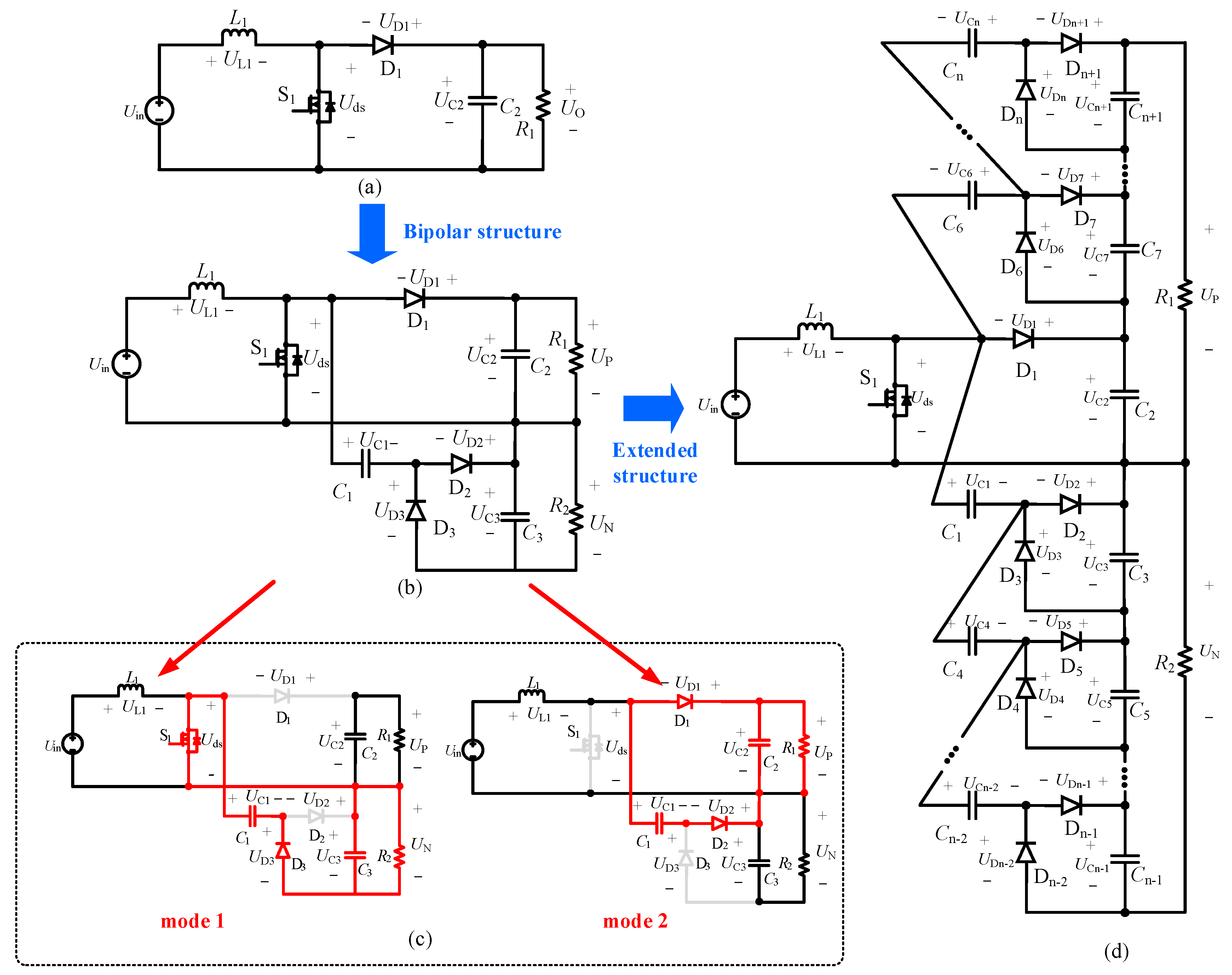
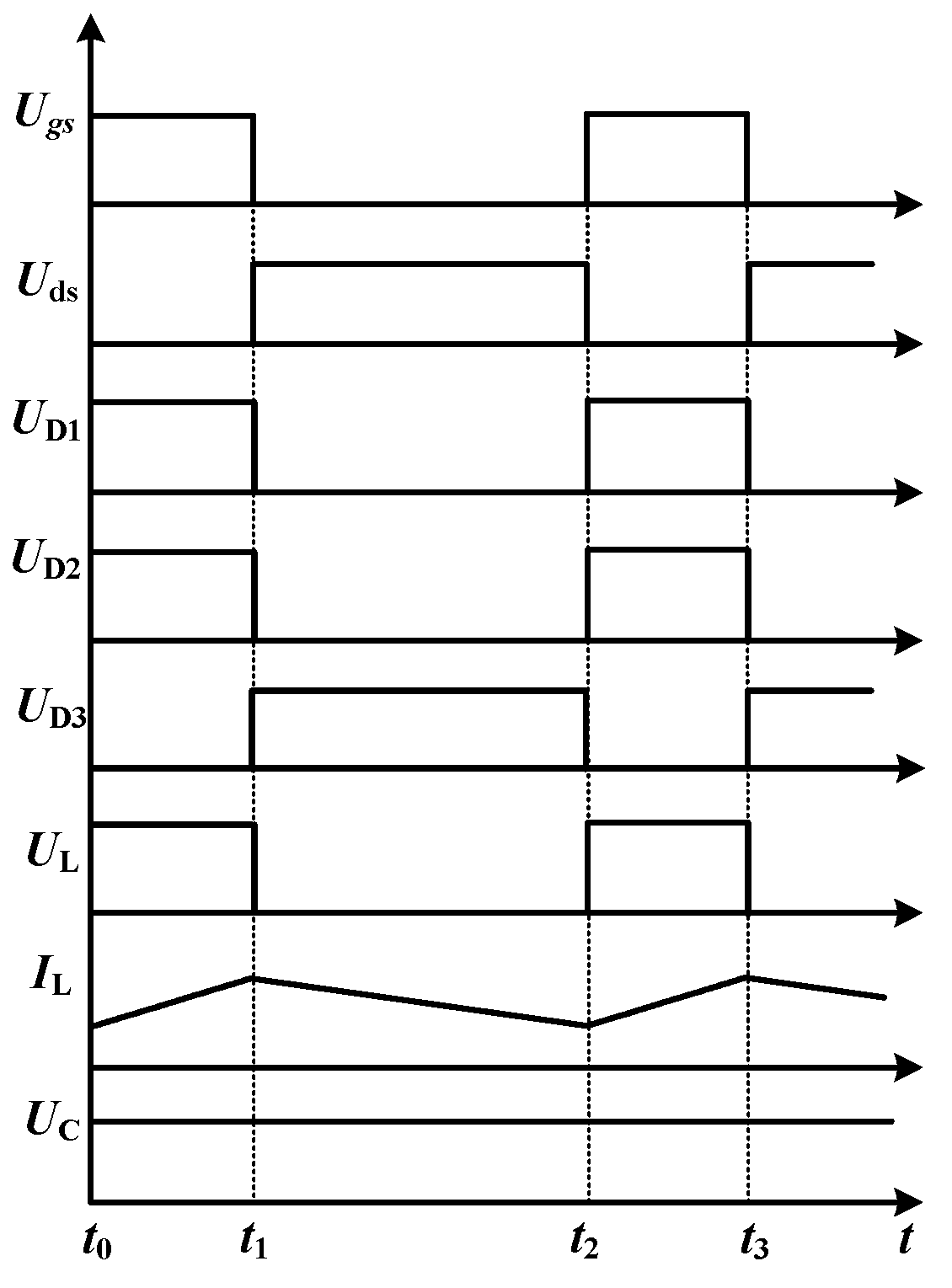
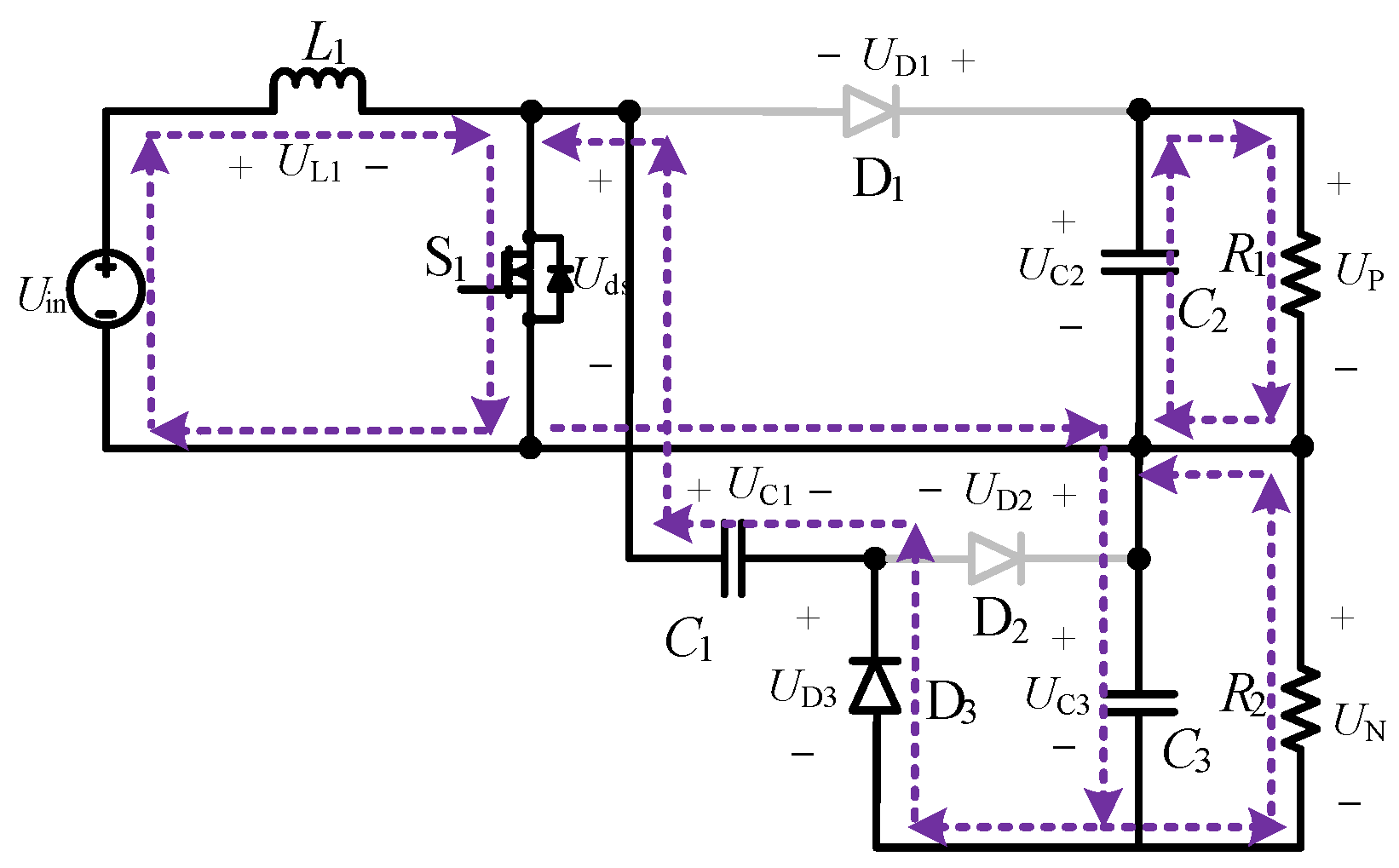
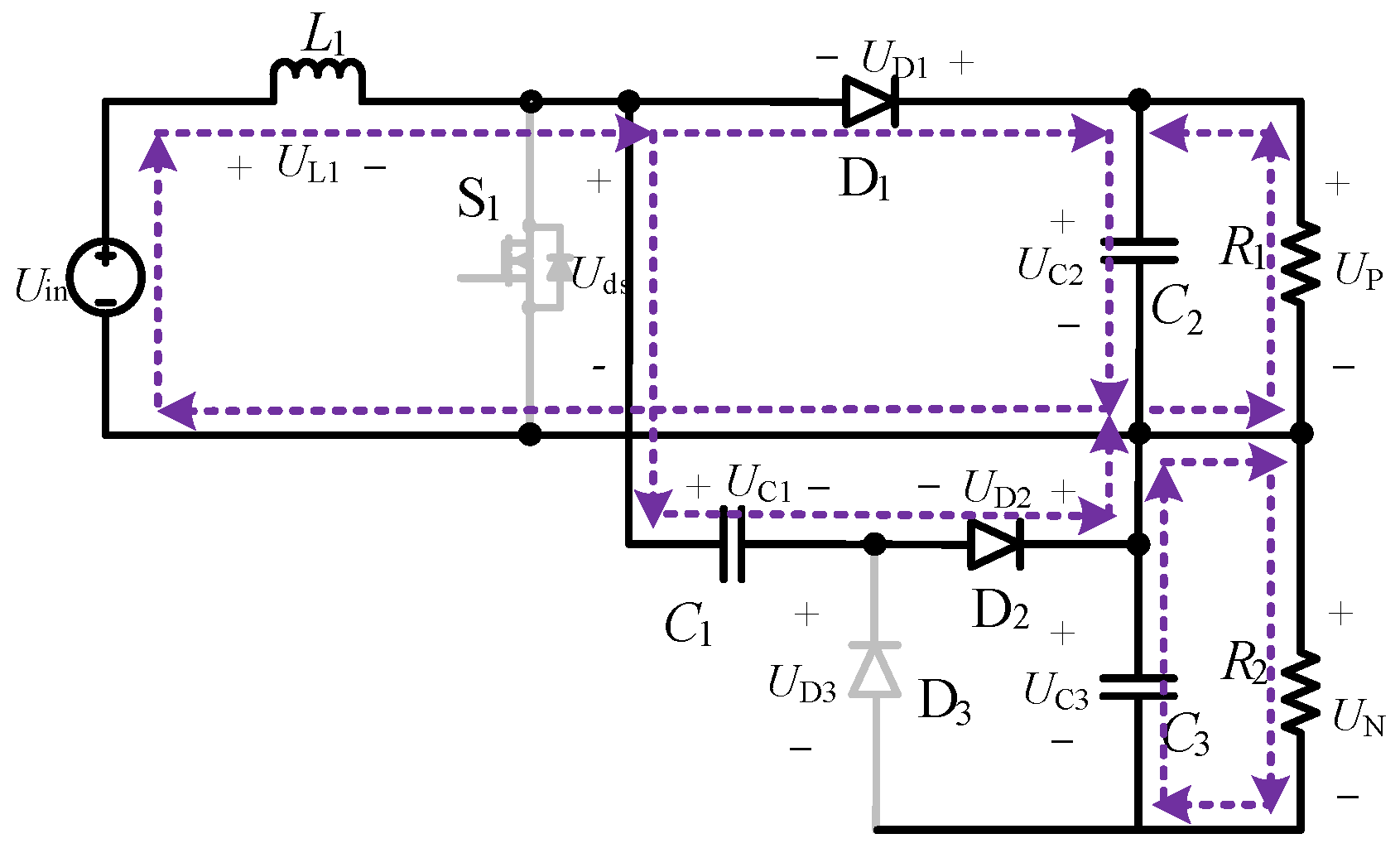
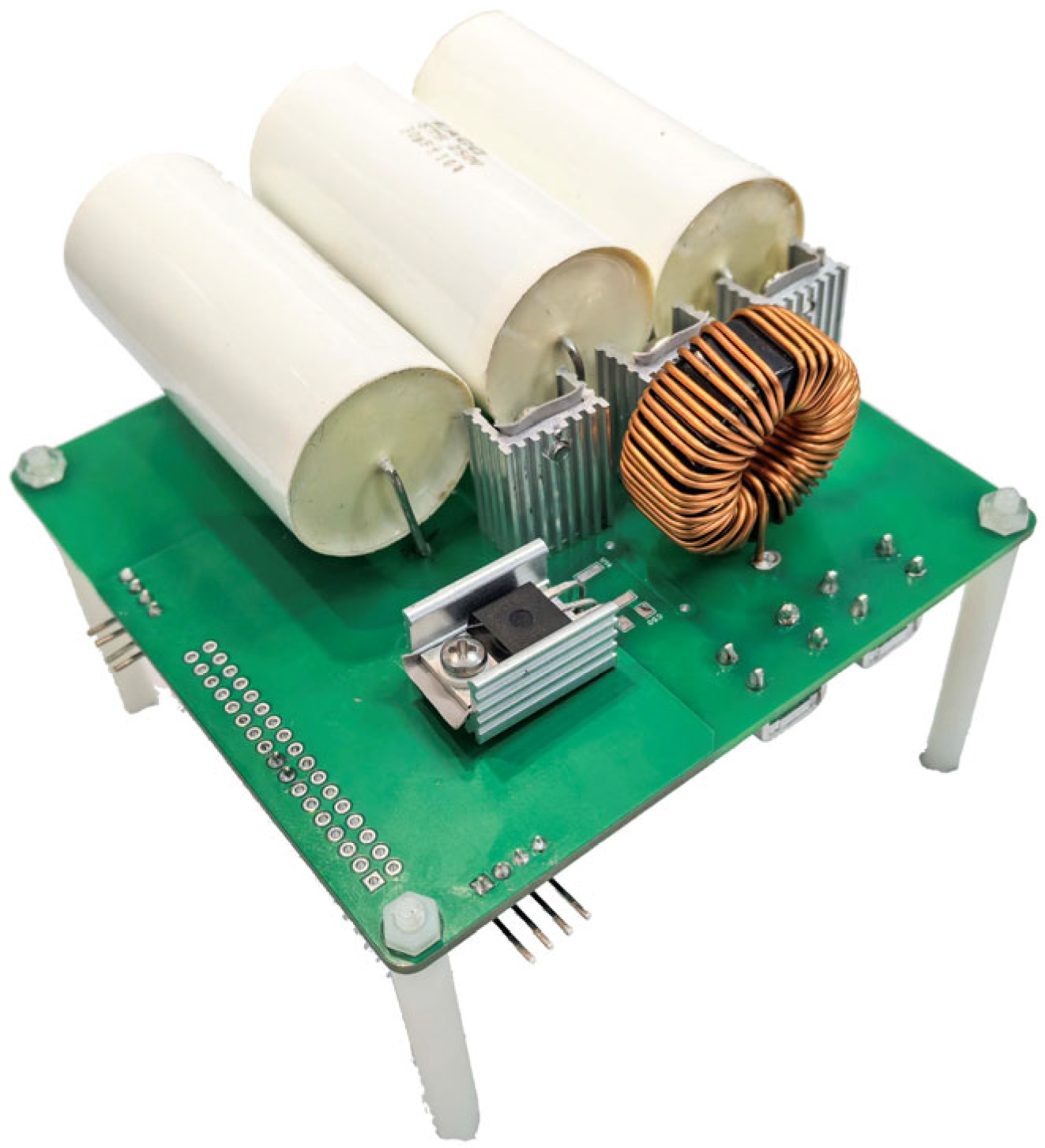

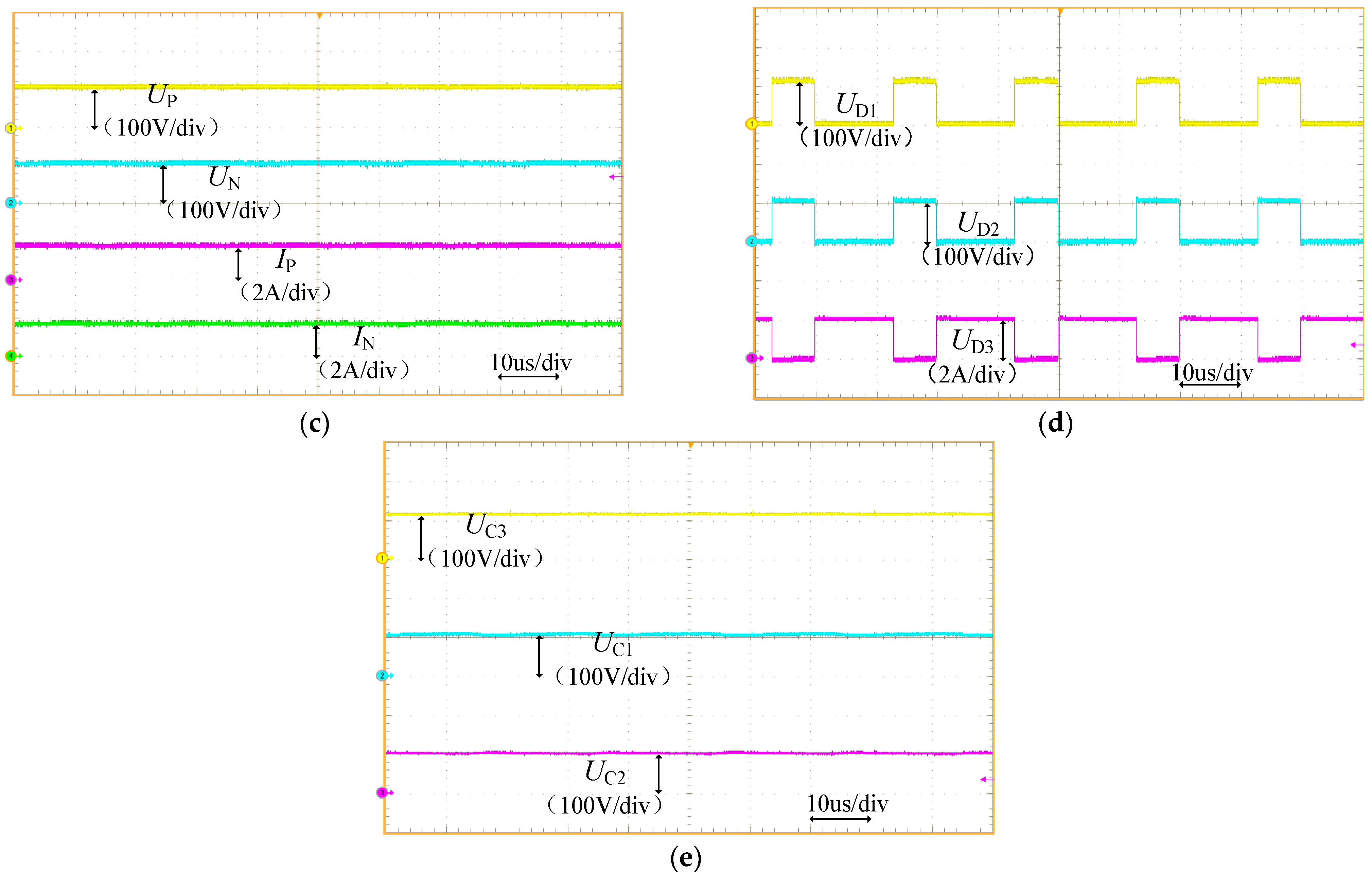


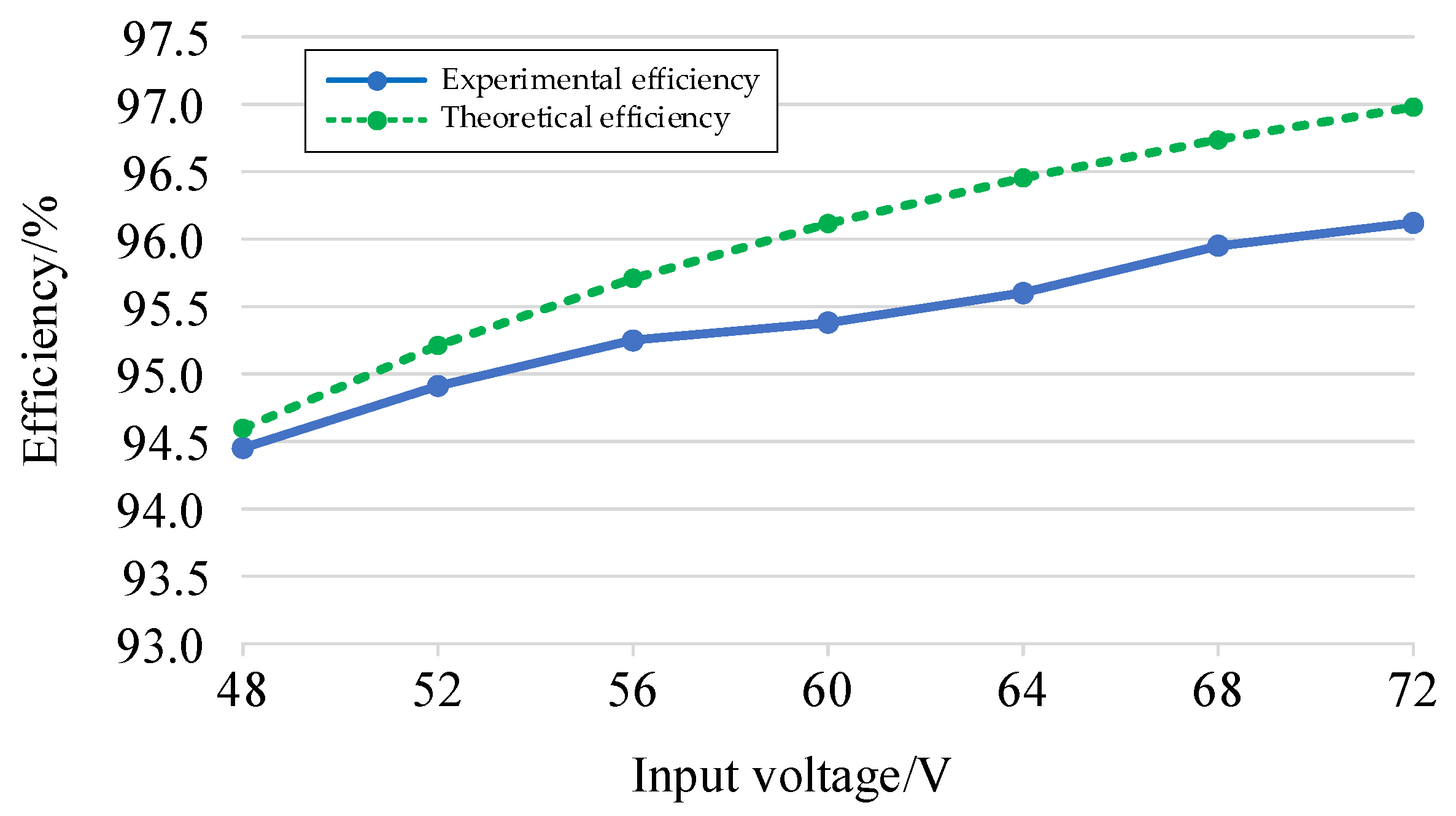
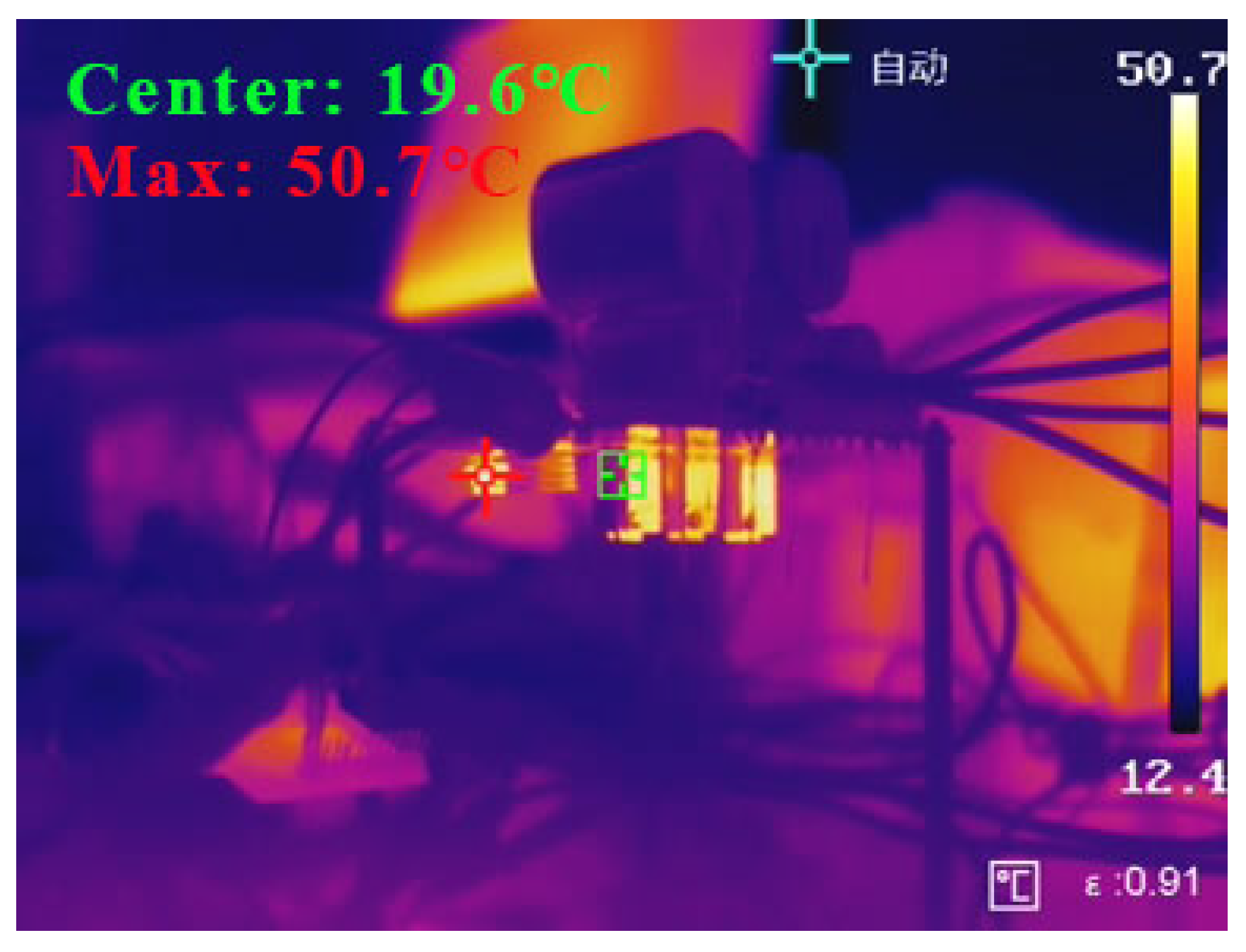
| Topology | [12] | [17] | [20] | [22] | Mentioned in This Article | |
|---|---|---|---|---|---|---|
| Number of devices | S | 2 | 4 | 2 | 2 | 1 |
| D | 0 | 2 | 2 | 4 | ||
| L | 1 | 1 | 3 | 1 + 1 (coupling) | 1 | |
| C | 2 | 2 | 3 | 4 | ||
| Voltage gain | 1 | 1 | 1/(1 − Db); D/(1 − Dz) | |||
| Control and drive mode | common | complex | complex | common | common | |
| Voltage self-balancing | no | no | no | no | yes | |
| scalable structure | no | no | no | no | yes | |
| Parameter | Value |
|---|---|
| input voltage | 48~72 V(Rated voltage 72 V) |
| output voltage | ±110 V |
| rated power | 400 W |
| frequency | 50 kHz |
| switch model | IPP200N25 |
| diode model | STTH8L06 |
| inductance | 500 μH |
| capacitance | C1, C2, C3: 30 μF |
Disclaimer/Publisher’s Note: The statements, opinions and data contained in all publications are solely those of the individual author(s) and contributor(s) and not of MDPI and/or the editor(s). MDPI and/or the editor(s) disclaim responsibility for any injury to people or property resulting from any ideas, methods, instructions or products referred to in the content. |
© 2025 by the authors. Licensee MDPI, Basel, Switzerland. This article is an open access article distributed under the terms and conditions of the Creative Commons Attribution (CC BY) license (https://creativecommons.org/licenses/by/4.0/).
Share and Cite
Liu, Y.; Li, Q.; Wang, Z. A Novel Low-Power Bipolar DC–DC Converter with Voltage Self-Balancing. J. Low Power Electron. Appl. 2025, 15, 43. https://doi.org/10.3390/jlpea15030043
Liu Y, Li Q, Wang Z. A Novel Low-Power Bipolar DC–DC Converter with Voltage Self-Balancing. Journal of Low Power Electronics and Applications. 2025; 15(3):43. https://doi.org/10.3390/jlpea15030043
Chicago/Turabian StyleLiu, Yangfan, Qixiao Li, and Zhongxuan Wang. 2025. "A Novel Low-Power Bipolar DC–DC Converter with Voltage Self-Balancing" Journal of Low Power Electronics and Applications 15, no. 3: 43. https://doi.org/10.3390/jlpea15030043
APA StyleLiu, Y., Li, Q., & Wang, Z. (2025). A Novel Low-Power Bipolar DC–DC Converter with Voltage Self-Balancing. Journal of Low Power Electronics and Applications, 15(3), 43. https://doi.org/10.3390/jlpea15030043





